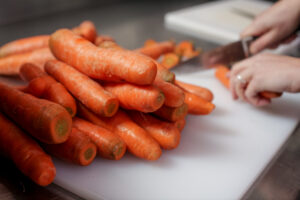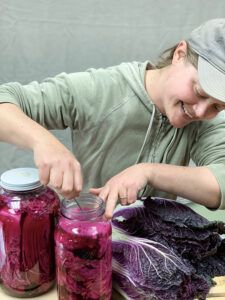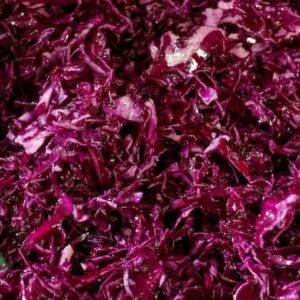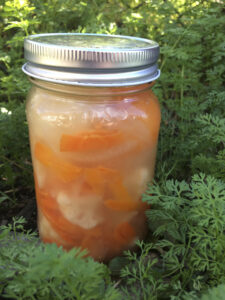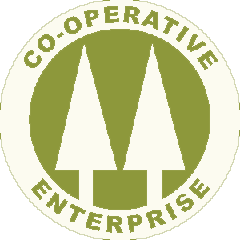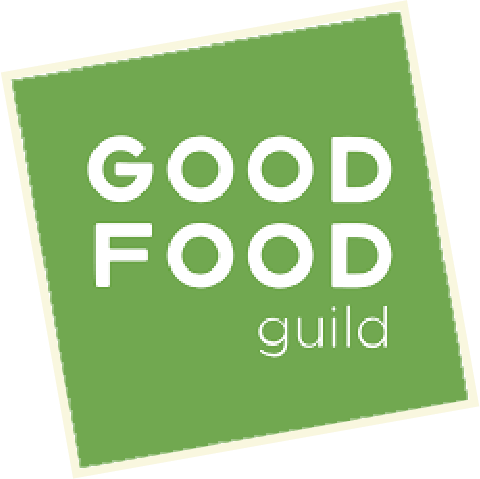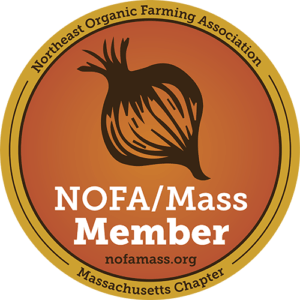
Happy Co-op Month! We’re proud to be celebrating our 10th anniversary as a worker co-op this year and invite you to check out our story about how we got here. We also share exciting founder succession news as longtime team member Kristin Howard takes Real Pickles into our second decade of co-op ownership as our next general manager!
Becoming a Co-op
“Fermented lettuce … really? I dunno.”
It’s the year 2000, and my future husband and business partner Dan is handing me a mason jar of yellowish-green, algae-like greens with a fork. It smells fresh and briny, but stirring the contents with the fork does not inspire tasting. In general, he could not have found a more willing taster for experimental fermentation. I’d rarely met a vegetable or a pickle I didn’t like. As a child at family picnics I sought out olives, pickled herring, cornichons, bread and butters, and uber-sour distilled vinegar pickles with yellow #5. I loved it all.
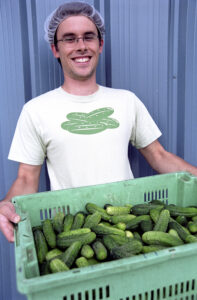
I took a small leaf and it was slimy on my tongue. “Um. I’ll pass,” I said.
“Apparently it’s a Russian delicacy…” he started, “but I really can’t see why, maybe there’s a missing ingredient.”
Fast forward 10 years and we’re at the helm of a fast-growing fermented pickle manufacturing company with a committed mission to source regional veggies and sell only within the Northeast U.S. We’ve left the lesser-known delicacies behind for more familiar recipes, crunchy krauts and cucumber pickles. Some folks recognize our ferments as reminiscent of those in the basement crocks their grandparents tended. We’ve just moved into our own facility after years working out of a local business incubator kitchen, and we can’t keep up with demand. The phone rings.
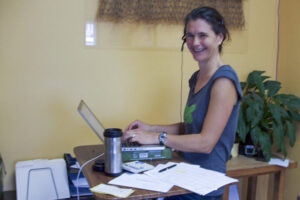
“Hello, Real Pickles, this is Kristin. … I’m sorry, we don’t ship to Tennessee… No, it isn’t about the price of shipping. We make everything with Northeast-grown vegetables and choose to distribute just in the Northeast. We want to promote local and regional food systems, so we like to encourage fermenters in other regions. I can recommend a business in Kentucky for you to try… here’s their number…”
In 2010, interest is growing big-time for fermented foods. Sandor Katz’s Art of Fermentation is about to hit the shelves and people are going crazy for anything fermented (even jackets made of dehydrated kombucha mushroom!). There’s a scattering of small businesses making fermented veggies and we’ve got a small list that we promote when folks call from outside our region. But we can barely keep up with sales inside our region. We start hoping for more regional competitors to absorb some of the demand.
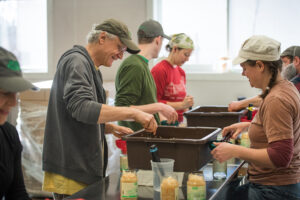
Our production schedule is full, the kitchen is packed with workers, we’re considering a second shift, but we like that everyone knows each other and is on the same schedule. There’s a great culture brewing among folks at our “pickle factory” (tongue in cheek). People are trading books and music, organizing skill swaps, sharing lunches. Folks seem happy to be here despite the hard work and tight quarters.
In 2010 when Dan and I thought about the future of Real Pickles, it was clear that workers were always going to be a big part of our business. It felt special to have a manufacturing business that could also be a supportive and nurturing environment for its workers. We wanted to preserve both our business’ mission AND improve working conditions so that staff would be able and excited to make a career out of their job here.
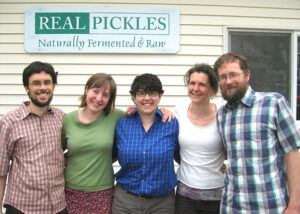
With a couple years of pondering and continuing to build a wonderful and committed staff, we invited them to join us in transitioning to a co-operative enterprise. With a small group of interested folks, we began to clarify our vision: a business whose mission is protected by its organizing documents and structure, and whose workers are empowered to protect and improve their own jobs and help create new good jobs within our community. A co-operative structure would also provide a succession strategy for Dan and I when we were ready to retire or pursue other careers.
On May 9th, 2013, after months of preparation and immeasurable support from our community, we made it official and became a worker co-operative with five founding members. We had written our bylaws, raised money through community investments, and signed the documents that articulated our intentions and inscribed our mission and guiding principles for all future employees. We were on our way!
Building Our Co-op Community

Fast forward another 10 years and we’re now celebrating a decade as a worker-co-op! The phone rings.
“Hi, this is Kate at Real Pickles… You are looking for the owner? … Well, I’m an owner. How can I help you?”
It’s 2023, and Kate, assistant sales manager, is one of 16 member-owners in our business out of a staff of 23. The remainder are eligible to join membership within a year. Running a business is not easy – the pandemic was rough, the climate crisis is impacting our farmers, and national competition is now a real thing. But we are making it work!

“I’m excited to be a part of something that is having a positive effect in supporting our local agriculture, local economy and our community. Being a member means that I can help shape the future of Real Pickles,” says Victor, vegetable coordinator since 2020 and member since 2022.
Alex joined Real Pickles in 2015 and became a member in 2018, saying, “This is my hometown, so it’s awesome to be a worker-owner of a company with such great values right here in my backyard.” Alex is the kitchen supervisor and keeps things running smoothly in the kitchen everyday. Reflecting on where we’ve come in 10 years of worker-ownership he says, “Our community has grown with folks from all over the globe and we’ve made it through many ups and downs. I’m proud of the way we take care of each other and strengthen the business for future generations of picklers.”

At Real Pickles, we work hard each day to have a positive impact on the world through our mission-driven co-op business. We believe that the food system needs more businesses whose approach builds toward health, justice, democracy, and climate stability. Our hope is that Real Pickles can be a model to demonstrate that it really is possible to make the kinds of choices as a business that move the food system in the direction it needs to go. For us this includes (among other things) producing truly nourishing food, sourcing exclusively from regional farms and selling only within our region, financing with mission-aligned investment, building an equitable workplace, and organizing ourselves as a worker co-op.
Longtime friend of Real Pickles, Joe Blumenthal, owned Downtown Sounds, a retail musical instrument store, for 40 years and was approaching retirement when he learned about our transition to a worker co-op. He says, “I couldn’t help thinking that I might be able to do something similar. I had a group of very able and trusted employees who I believed could take over the store but who didn’t have the money to buy the business. We eventually converted the store to a co-op, and I have been happily retired for four years now while my former employees have successfully survived the pandemic and adapted to retail in the age of Amazon. It all started with that conversation about Real Pickles.”
Many business owners nearing retirement or at a career transition hope to find a founder succession strategy that will retain their mission and employees. We’ve gotten dozens of calls from other businesses curious about our path, and we hope to continue inspiring folks to consider the co-operative model. When we first proposed converting Real Pickles, Dan and I didn’t have specific ideas about how much longer we’d be involved. But the worker co-operative structure felt like just the right one to have in place to ensure that, when the day came for Real Pickles’ founder succession, its jobs and values would be well-protected in the process.
Our Next Decade and Beyond
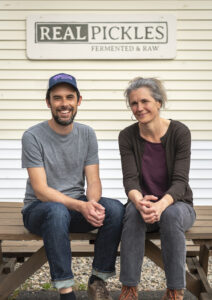
Now as we’re celebrating our 10th anniversary as a co-op, that day has indeed arrived. Dan has led Real Pickles as its general manager for 22 years and is ready to step down. I am also moving on to a new career opportunity. Over the past year, we have developed a plan to transition from Dan’s leadership to Kristin as our new general manager. Kristin joined Real Pickles in 2008 as our first sales manager and was part of the original team that led our conversion to a worker co-op. Beginning October 30th, she’ll be Real Pickles’ new general manager! We couldn’t be more excited and confident in Kristin’s wealth of experience and time-tested skill.
Kristin says, “I’m excited to be taking on the general manager role at Real Pickles. I believe deeply in our social mission – our commitment to healthy food, a regional organic food system and co-operative workplaces. I’m grateful for the organizational foundation that Dan and Addie Rose built in the years before I arrived and proud of the work we’ve done together since to further develop Real Pickles into a successful, mission-driven business.”
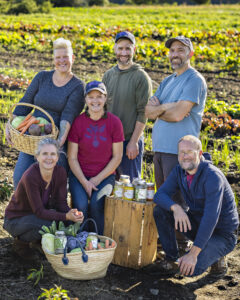
“I’m so glad we made the decision to turn Real Pickles into a worker co-op,” says Dan. “Becoming a co-op advanced our social mission and protected it at the same time. It also helped us to build a devoted and skilled team that has made Real Pickles a stronger and more resilient organization than ever before. Now, with Kristin as its next leader, Real Pickles is well-positioned for success and positive impact for many more years to come.”
As we enter our second decade as a mission-driven co-op – and now led by its next generation of leadership – we look forward to Real Pickles continuing to make a positive difference in the world. And as ever, we are deeply grateful for the community support that has guided our path over these past 22 years. Thank you and happy Co-op Month, everyone!!
Photos featured in this blog post are by Natalie Conn, Jim Gipe, Kate Hunter and Matthew Cavanaugh

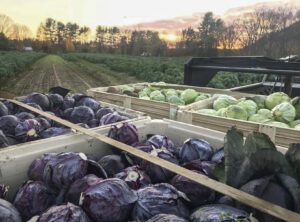
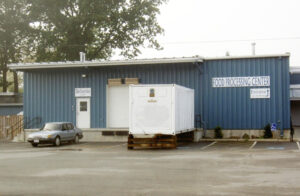
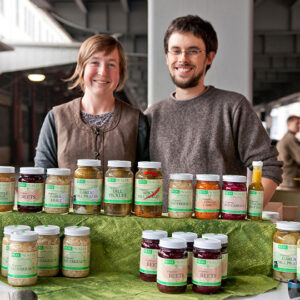


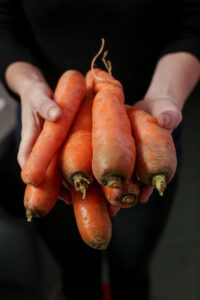 Do you have an abundance of cabbage, daikon, cucumbers, or beets from your garden or CSA share? Do you have memories of pickles and sauerkraut bubbling away in a crock in your grandparents’ cellar? Would you like to recreate these in your own kitchen? If you’re brand new to fermentation, you are in the right place! Here is our two-part guide to get you started experimenting with this traditional fermentation technique for preserving vegetables and creating delicious, fermented flavors! In this post we’ll take you step by step through 2 different methods for fermenting vegetables, and in
Do you have an abundance of cabbage, daikon, cucumbers, or beets from your garden or CSA share? Do you have memories of pickles and sauerkraut bubbling away in a crock in your grandparents’ cellar? Would you like to recreate these in your own kitchen? If you’re brand new to fermentation, you are in the right place! Here is our two-part guide to get you started experimenting with this traditional fermentation technique for preserving vegetables and creating delicious, fermented flavors! In this post we’ll take you step by step through 2 different methods for fermenting vegetables, and in 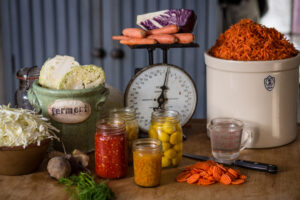 For these recipes, you will need:
For these recipes, you will need: